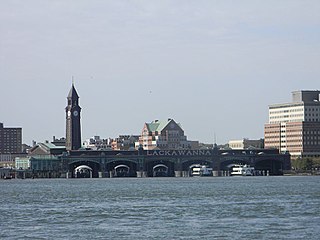
Hoboken Terminal is a commuter-oriented intermodal passenger station in Hoboken, Hudson County, New Jersey. One of the New York metropolitan area's major transportation hubs, it is served by eight NJ Transit (NJT) commuter rail lines, an NJ Transit event shuttle to Meadowlands Sports Complex, one Metro-North Railroad line, various NJT buses and private bus lines, the Hudson–Bergen Light Rail, the Port Authority Trans Hudson (PATH) rapid transit system, and NY Waterway-operated ferries.
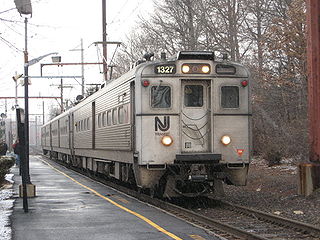
The Gladstone Branch is a commuter rail line operated by NJ Transit from Gladstone station, in the U.S. state of New Jersey, to either Hoboken Terminal or New York Penn Station. It is one of two branches of the Morris & Essex Lines.

The Morristown Line is an NJ Transit commuter rail line connecting Morris and Essex counties to New York City, via either New York Penn Station or Hoboken Terminal. Out of 60 inbound and 58 outbound daily weekday trains, 28 inbound and 26 outbound Midtown Direct trains use the Kearny Connection to Penn Station; the rest go to Hoboken. Passengers can transfer at Newark Broad Street or Summit to reach the other destination. On rail system maps the line is colored dark green, and its symbol is a drum, a reference to Morristown's history during the American Revolution.

Newark Broad Street station is a New Jersey Transit commuter rail and light rail station at 25 University Avenue in Newark, New Jersey. Built in 1903, the station's historic architecture includes an elegant clock tower and a brick and stone façade on the station's main building. In June 1984, the station was added to the National Register of Historic Places in recognition of its historical significance.
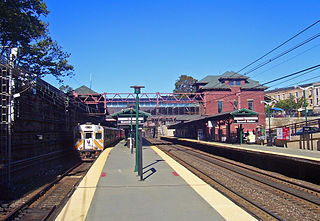
Summit is a train station in Summit, New Jersey, served by New Jersey Transit's Morris & Essex Lines. The station sits between Union Place on the north and Broad Street on the south, with station access via either side, and between Summit Avenue on the east and Maple Avenue on the west. Constructed in 1904–1905 by the Delaware, Lackawanna and Western Railroad in a mile-long open cut, it is one of the few NJ Transit stations with platforms below street level.

Brick Church is an active commuter railroad station in the city of East Orange, Essex County, New Jersey. The station, one of two in East Orange, is located next to the Temple of Unified Christians Brick Church, designed with brick architecture. The other station, located 0.6 miles (0.97 km) to the east, is the namesake East Orange stop. Trains from the station head east on New Jersey Transit's Morristown Line and Gladstone Branch to New York Penn Station and Hoboken Terminal while westbound trains service stops out to Gladstone and Hackettstown. Like its sister station, Brick Church contains three tracks and two platforms. However, it is not accessible for the handicapped.

Orange is an active commuter railroad train station in the city of Orange, Essex County, New Jersey. One of two stops in the city, it is served by New Jersey Transit's Morris and Essex Lines: the Morristown Line to Hackettstown and the Gladstone Branch to Gladstone for trains from New York Penn Station and Hoboken Terminal. Orange station contains two low-level side platforms and three tracks.

Highland Avenue is an active commuter railroad station in the city of Orange, Essex County, New Jersey. One of two in the city, along with the eponymous Orange station, Highland Avenue is serviced by trains of New Jersey Transit's Morris and Essex Lines: the Morristown Line and Gladstone Branch. Trains through the station run between New York Penn Station and Hoboken Terminal to the east and Hackettstown and Gladstone. The station contains two low-level side platforms for the three tracks that run through the station.

Mountain Station is a New Jersey Transit station in South Orange, Essex County, New Jersey, United States, along the Morris and Essex. The station, built in 1915, was designed by Frank J. Nies. It has been listed in the New Jersey Register of Historic Places and National Register of Historic Places since 1984 and is part of the Operating Passenger Railroad Stations Thematic Resource.
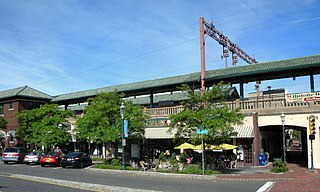
South Orange is a New Jersey Transit station in South Orange, New Jersey along the Morris and Essex rail line. It is located in the business district of South Orange, near its town hall. It is one of two train stations in the township of South Orange, Mountain Station being the other near the township border. South Orange station was built by the Lackawanna Railroad in 1916.

Maplewood is a train station that serves New Jersey Transit's Morristown Line and Gladstone Branch in the township of Maplewood, Essex County, New Jersey. Located in "The Village" in Maplewood at 145 Dunnell Road, the station services trains from New York Penn Station and Hoboken Terminal to the east along with trains to Summit, Dover, Hackettstown and Gladstone to the west.

Millburn is a New Jersey Transit station in Millburn, New Jersey along the Morristown and Gladstone lines.
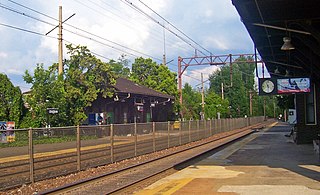
Chatham is a railway station in Chatham, New Jersey. A commuter rail station, Chatham receives rail service from statewide provider NJ Transit on its Morristown Line, a branch of the Morris & Essex Lines. Trains on the Morristown Line go to both Hoboken Terminal and New York Penn Station.

Denville is an active commuter railroad train station in Denville Township, Morris County, New Jersey. Located on Estling Road, the station contains three side platforms–two curved low-level platforms that service New Jersey Transit's Morristown Line, and a third that services their Montclair-Boonton Line. Both platforms on the Morristown Line contain miniature high-level platforms for handicap accessibility. Trains on both lines operate between Hoboken Terminal, New York Penn Station and Hackettstown. Heading westbound, the next station is Dover while the next station east on the Morristown Line is Mount Tabor. The next station east on the Montclair-Boonton Line is Mountain Lakes.

Dover is an active commuter railroad train station in the borough of Dover, Morris County, New Jersey. Located at the end of electric service, Dover station serves as a secondary terminal of NJ Transit's Morristown and Montclair-Boonton Lines. Non-electric service continues west to Hackettstown on both lines. The next station to the west is Mount Arlington while the next station to the east is Denville. Dover station consists of a single island platform, accessible for the handicapped.

Lyons is a New Jersey Transit station in Basking Ridge, New Jersey along the Gladstone Branch of the Morris & Essex Lines. The station serves south Basking Ridge as well as the Hills and Liberty Corner.

Gladstone is a New Jersey Transit station in Peapack-Gladstone, Somerset County, New Jersey, United States. It is the western terminus of the Gladstone Branch of the Morris and Essex line. A yard is to the east of the station.
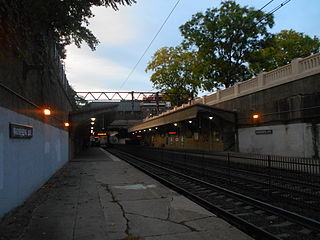
Watsessing Avenue station is a New Jersey Transit rail station in Bloomfield, New Jersey, along the Montclair-Boonton Line. It is located beneath the Bloomfield Police Benevolent Association meeting hall near the corner of Watsessing Avenue and Orange Street in Bloomfield. It is one of two stations on the line where the boarding platform is below ground level. The Watsessing station and the Kingsland station in Lyndhurst on the Main Line shared similar designs and were built about the same time.

Roseville Avenue was a transfer station on New Jersey Transit's Morris & Essex Lines in Newark, New Jersey, United States. The station was built by the Delaware, Lackawanna and Western Railroad in 1903 as part of a project to lower the tracks below the road surface to eliminate grade crossings. It serviced Newark's Roseville neighborhood. It once had two tracks on the Lackawanna mainline and two low-wall platforms, with an additional platform along the Montclair Branch. The station remained in service during most of the 20th century, until New Jersey Transit closed the station on September 16, 1984.

Ampere, formerly known as The Crescent, is a defunct stop on New Jersey Transit's Montclair-Boonton Line in the city of East Orange, Essex County, New Jersey, United States. A station was first built there in 1890 to service to new Crocker Wheeler plant in the district. The stop was named in honor of André-Marie Ampère, a pioneer in electrodynamics and reconstructed as a new Renaissance Revival station in 1908. Ampere was the second stop on the branch west of Newark Broad Street Station until 1984, when the Roseville Avenue station was closed. In June of that year, the station, along with 42 others, was entered into the National Register of Historic Places. In 1986, after continuous deterioration, New Jersey Transit demolished the westbound shelter built in 1921. The agency discontinued rail service to Ampere on April 7, 1991. The entire station was demolished in 1995.























